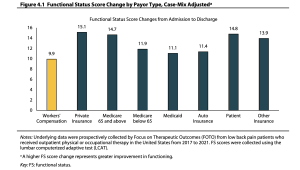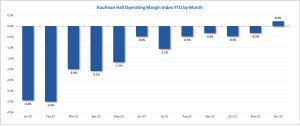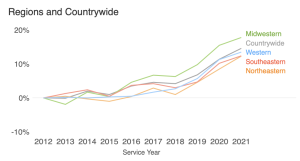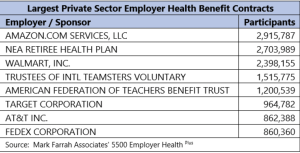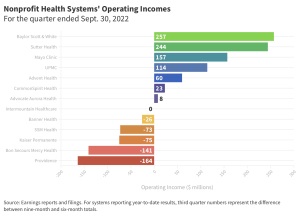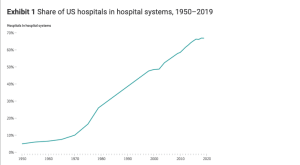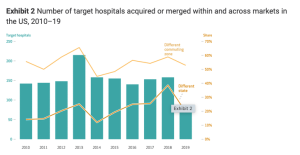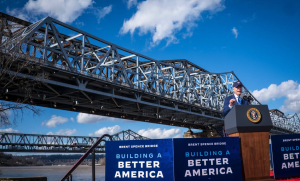Yesterday we dug into my prescience – or lack thereof – as laid out in my first 5 predictions about workers’ comp in 2022.
Today, it’s the second 5.
6. With one or two exceptions, don’t expect much in the way of private equity investments.
There may be one or two large transactions, and a couple small ones, but outside of that, the bloom on the workers’ comp rose appears to be fading.

Verdict – True.
Enlyte’s sale didn’t happen; sources indicate the price offered didn’t hit the level its owners needed for the big bonuses to kick in. Not good for the employees with options…
Other efforts – MTI America and Medata among them – also didn’t result in sales, while TRISTAR bought Risico and Carisk acquired Advanced Claim Review Specialists – both deals make a lot of sense strategically. There were a few other, smaller transactions, but nothing like what we saw 5+years back.
Oh, and the deals that did happen were NOT PE firm acquisitions, rather strategic investments by other companies in the space.
Adding to that is the reduction in the number of firms interested in workers’ comp services…unlike the halcyon days a few years ago, there are far fewer PE firms focusing on work comp.
7. OneCall will be sold and/or split up.
The BlackRock and KKR entities that are the current owners are not operators; they are debt owners. CEO Tom Warsop has squeezed out all the squeezable costs – and then some. Growth – defined as new business from new customers – is not happening. Add the overall drag on work comp services from the still-real drop-off in claims and claims services, and the reasons to hold on and hope are few indeed.
Plus, if interest rates increase – which is a distinct possibility – and if private equity interest in workers’ comp continues to diminish from it’s current modest level – also a distinct possibility – OCCM’s owners may well decide to sell soon rather than watch values decline.
Verdict – Nope. OCCM continues to soldier on, although Sedgwick’s move to internalize those services and the continued structural decline in claims frequency make the future uncertain at best.
8. COVID’s impact on costs and rates will prove to be minimal.
COVID claims are cheap, few are anywhere close to catastrophic cost levels, the effect of presumption laws and regulations is not much of an effect at all, and many employers – especially health systems – are forcing employees to use PTO rather than file for WC when they test positive/have symptoms.
Most research organizations and actuaries would do well to reflect how their early predictions were so…bad.
Helpful hint – two places to start; a) the tendency for WC “experts” to catastrophize and b) the almost-complete lack of understanding of healthcare drivers, costs, cost structures, reimbursement, and epidemiology.
Verdict – True.
All the credible research indicates COVID hasn’t been expensive – if anything claims are less costly than non-COVID claims.
9. There will be no big issues in workers’ comp. “Big” defined as important, needle-moving, disruptive, revolutionary.
No, medical marijuana is NOT a big issue – neither is COVID, or presumption, or the mid-term elections (there is ZERO interest in workers’ comp on the federal level) or remote work (does anyone seriously believe office workers tripping over toys will amount to any real dollars?)
Oh, and with rates at all time lows, frequency continuing to drop, and medical costs (with the exception of physical therapy and facilities) flat, coupled with ongoing supply chain and labor market issues, execs at big employers are (justifiably) completely uninterested in workers’ comp.
If the big girls and boys don’t see any issues, there aren’t any.
Verdict – True.
While some pundits/erstwhile “experts” would have you think medical marijuana, COVID, employment, or other issues even more tangential are going to be big issues, reality is there are no big issues in workers comp – save the decades-long drop in claims frequency.
10. Here’s the kicker – the biggest long-term concern for workers’ comp is global warming...yet this is getting zero attention.
There’s going to be an inevitable increase in issues related to heat, flooding, fires, drought, tornados and hurricanes. This is getting more real every day yet remains all-but-ignored by pundits, policy-makers and rate-makers. We can expect more heat-related claims. Hurricanes, fires, and tornados will increase in number and severity; affecting logistics, labor, construction, and claims. The research is clear.
Verdict – True.
Yep this is going to be a controversial finding, especially among the human-driven climate change deniers (and other flat-earthers).
Storms are getting more severe, heat-associated “injuries” increasing, and other major weather events (tornadoes, massive blizzards, deep cold snaps) are happening more often and with more intensity.
The verdict.
I got 8 correct, one flat-out wrong, and one is TBD.
